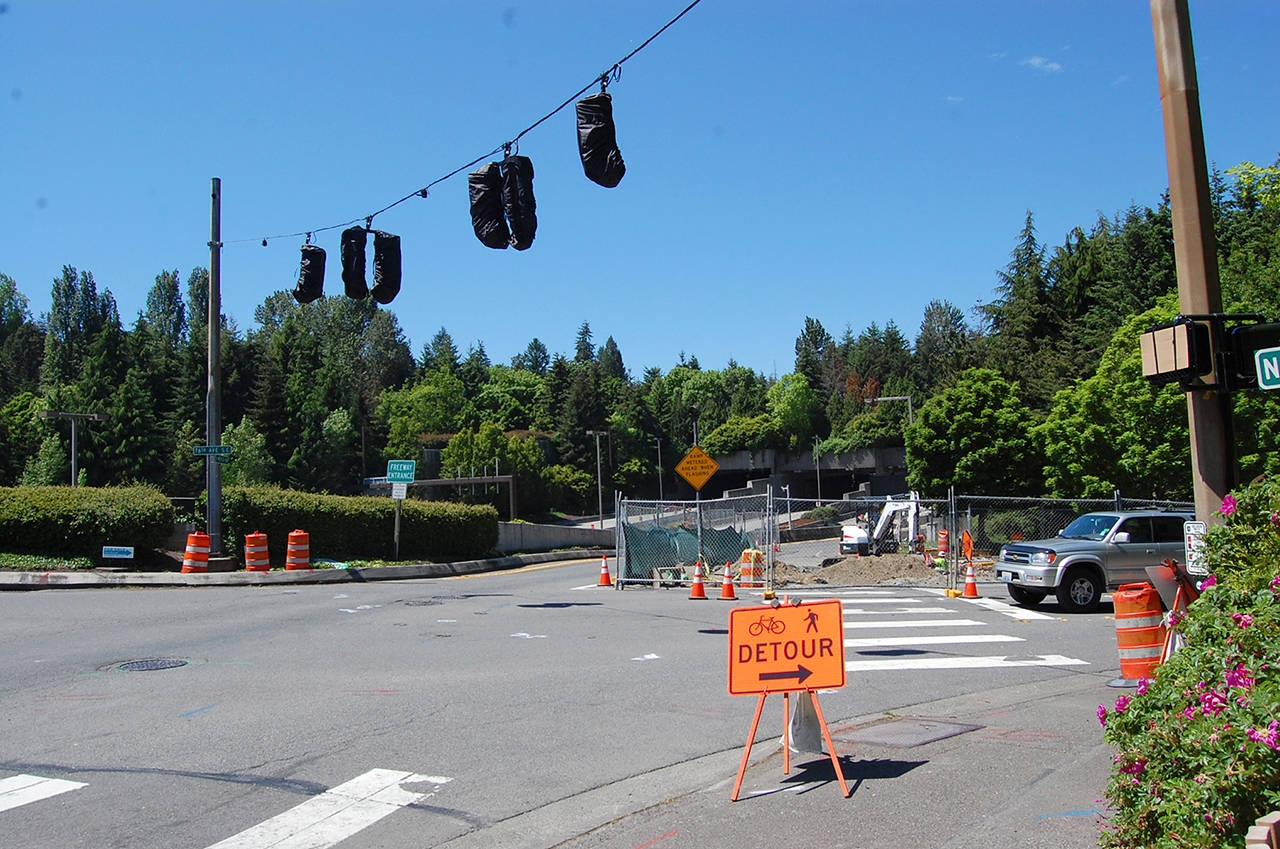The Interstate 90 center lanes closed on June 4. Mercer Island commuters can expect major changes to:
The highway configuration
East Link light rail will run across the I-90 center roadway bridge between Seattle and Mercer Island, and will permanently displace all vehicle traffic onto the mainline roadways. The Washington State Department of Transportation (WSDOT) has been installing carpool/high occupant vehicle (HOV) lanes in each direction on the current mainline roadway of I-90, under a project known as R8A-Stage 3.
In order to add a new HOV lane in each direction, WSDOT narrowed all lanes from 12 to 11 feet and reduced the width of the shoulders. The new lanes are slightly wider than the current lanes in the eastbound Mount Baker Tunnel, which are 10.5 feet.
The city addressed many questions, including emergency service access to the floating bridge in gridlocked traffic, in a mailer to Islanders and in an FAQ on its website, www.mercergov.org/Rail-FAQ.
State law requires traffic to move over as much as possible to allow access for fire department vehicles. Although the shoulders of the westbound roadway will be narrowed to 6 feet and 2 feet, there will still be some space for cars to move aside. There are numerous locations in the region, such as much of I-5 through downtown Seattle, where there is either no shoulder, or not one wide enough for driving emergency vehicles, but emergency vehicles have still demonstrated they are able to access incidents in these areas.
In the rare case of an incident fully blocking traffic on all four future lanes of the westbound floating bridge, police and fire first responders from Seattle can access the scene by driving the “wrong way” along the westbound roadway, as has occurred in emergencies in downtown Seattle occasionally. This would only be used after consultation and agreement through the State Patrol and WSDOT, and after it was determined the initial units could not access the location because of traffic. The eastbound roadway of the floating bridge will have one 8-foot shoulder and one 4-foot shoulder, and is less space-constrained.
The city held a listening session focused on this issue in the spring of 2017.
City streets and intersections
Starting May 17, Sound Transit crews have been restriping lanes, installing traffic signals and traffic cameras, adding a transit bypass lane and converting existing ramps for metering at intersections near I-90.
Construction of light rail will eliminate the existing ramps that provide connections to the center roadway. The express lanes ramps at 77th Avenue Southeast and Island Crest Way will close. The westbound Island Crest Way on-ramp will become HOV only. An eastbound HOV exit from the new HOV lane to Island Crest Way will open in mid-July. The existing right side exit will remain open.
A bus bypass is being added to the North Mercer Way/76th Avenue Southeast ramp, which will provide buses the opportunity to bypass the ramp meter when it is on. Also at that intersection, crews are installing a temporary traffic signal, modifying the I-90 trail connection per the city’s request and removing the right turn lane and island from north approach.
Temporary traffic signals will be erected on North Mercer Way at 76th Avenue Southeast and 77th Avenue Southeast, and WSDOT traffic cameras will be added above I-90 at 80th Avenue Southeast and at Island Crest Way. The Island Crest Way overpass will also be re-striped to lengthen turn lanes. WSDOT will also do some lane prep work for a possible future alternating, two-lane metered entrance at West Mercer Way, which would remove today’s HOV bypass.
Long-standing regional agreements require that permanent traffic mitigation measures be complete prior to light rail opening, scheduled for 2023. Mercer Island does not agree that this timing is adequate, and is pushing for mitigation to be completed sooner, according to the city’s FAQ.
Single occupant vehicle access
In August 2016, the Federal Highway Administration (FHWA) determined that single occupant vehicle (SOV) traffic would not be able to use the new HOV lanes built as part of the R8A configuration, which had been an assumption during the planning stages.
Since the westbound Island Crest Way on-ramp will become HOV-only on June 3, Islanders driving alone will no longer be able to use it. Solo drivers will need to use 76th Avenue Southeast, East Mercer Way or West Mercer Way to access westbound I-90. Today, all vehicles may use the Island Crest Way ramp, which carries 40 percent of the Island’s morning commuters to westbound I-90.
The Mercer Island City Council is fighting this determination, and voted to sue WSDOT and Sound Transit in February 2017 for breach of contract. A court hearing is occurring on June 1. The council also recently sent a letter to the U.S. Department of Transportation, requesting grandfathered SOV access to the Island Crest Way ramp. On May 23, the city received notice from the FHWA reiterating its opposition to SOV access to HOV lanes.
Although the city is pursuing various litigation strategies, these are unlikely to be resolved before June 3. If the ramp restriction is implemented, the city believes this will divert up to 1,000 vehicles per hour during the morning commute to alternative westbound on-ramps, creating greater congestion in Town Center, and pushing traffic onto local streets, such as Southeast 40th Street and West Mercer Way, according to a recent mailer.


